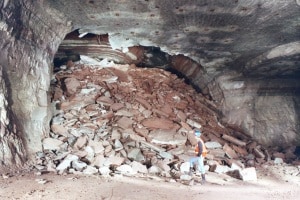Mining Topic: Roof Support
What is the health and safety problem?
All underground mines can be subjected to ground falls. As a result, over 90% of the more than 700 underground mines use some form of roof or rib support. Therefore, ground falls represent a significant hazard to undergrounds mine workers. Appropriate support selection and adequate support system design is critical to the prevention of the ground falls and ground fall accidents.
What is the extent of the problem?
Ground fall accidents in underground mines cause 8 to 10 fatalities and more than 800 injuries every year. This represents about 30% of the fatal accidents and 15% of the injuries that occur each year in underground mines. In addition, there are nearly 2,000 reportable non-injury ground falls.
How is the NIOSH Mining Program addressing this problem?

Ground fall.
The NIOSH Mining Program has conducted research on a number of issues pertaining to ground support. Research areas include the design and performance of intrinsic support systems, the performance of standing support systems, surface control systems, and the effects and mitigation of horizontal stress.
What are the significant findings?
NIOSH Mining research has developed information and software on the design and performance of various ground support systems including:
Standing Support Systems – The Support Technology Optimization Program (STOP) is a software package that provides load-displacement performance curves, design guidelines, and recommendations for the installation and use over 100 different types of standing supports. The load-displacement characteristics of the standing support systems are determined in the NIOSH Mining Mine Roof Simulator (MRS).
Intrinsic Roof Support – An empirically based software package, Analysis of Roof Bolt Systems (ARBS), has been developed to assist in design of roof bolt systems in coal mines.
Surface Control – NIOSH Mining publications have documented the advantages of using roof screen or mesh to prevent ground fall injuries. The performance characteristics of the roof screen have also been developed. For shotcrete, tools have been developed to measure the early strength, toughness, and in situ adhesion and installation quality.
Coal Mine Roof Rating (CMRR) – The Coal Mine Roof Rating is a roof classification system that was first introduced to the mining community in 1994. The CMRR is a rock mass classification system that calculates the inherent strength of coal mine roof, primarily within the bolted horizon. It can be used in the design of gateroads, roof bolt selection, extended-cut decisions, and numerical modeling.
Stone Mine Roof Span Design – A survey on roof span issues and design practices discusses the observed factors contributing to roof instability.
What are the Next Steps?
NIOSH Mining is researching the design of roof support systems in coal mines by developing an improved understanding of how intrinsic support systems function in supporting coal mine roofs. Testing of new standing support systems is ongoing in the Mine Roof Simulator.
- Analysis of Roof Bolt Systems
- An Approach to Identifying Geological Properties from Roof Bolter Drilling Parameters
- Calibration and Verification of Longwall Stress Models
- Coal Mine Geology in the U.S. Coal Fields: a State-of-the-art
- Computer Simulation of Ground Behaviour and Rock Bolt Interaction at Emerald Mine
- Development and Application of the Coal Mine Roof Rating (CMRR)
- Developments in Sealant Support Systems for Ground Control
- Methods of Determining the Orientations of Bedrock Fracture Systems in Southwestern Pennsylvania and Northern West Virginia
- Mistakes, Misconceptions, and Key Points Regarding Secondary Roof Support Systems
- Numerical Model Calibration for Simulating Coal Pillars, Gob and Overburden Response
- Optimizing Secondary Roof Support with the NIOSH Support Technology Optimization Program (STOP)
- Performance Characteristics for Welded Wire Screen Used for Surface Control in Underground Coal Mines
- Pillar Mechanics of Coal Mine Bursts: A Control Strategy
- Proceedings: New Technology for Coal Mine Roof Support
- Proceedings: New Technology for Ground Control in Retreat Mining
- Pumpable Roof Supports: An Evolution in Longwall Roof Support Technology
- Rock Mechanics Investigations at the Lucky Friday Mine (In Three Parts): 1. Instrumentation of an Experimental Underhand Longwall Stope
- Roof Span Design for Underground Stone Mines
- Shear Mechanism for Mining-Induced Fractures Applied to Rock Mechanics of Coal Mines
- Technology News 526 - Proceedings of the International Workshop on Rock Mass Classification in Underground Mining